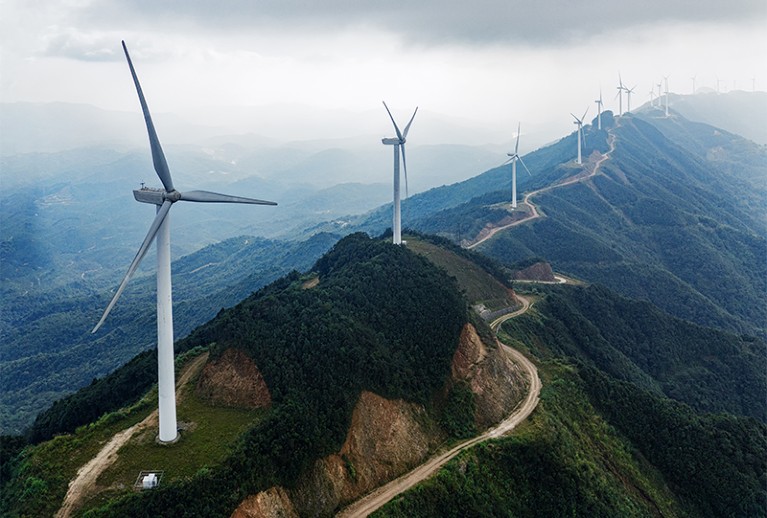
A wind farm near Heyuan City in Guangdong, China.Credit: Haitong Yu/Getty
In global energy rankings, one country stands out. China is the world’s hungriest consumer of energy worldwide — demanding the energetic equivalent of almost 3.3 billion tonnes of oil last year. Since 2011, it has burnt more coal than all other countries combined. And its reliance on this fossil fuel adds up: China emits around one-quarter of the world’s greenhouse gases, the largest share of any country.
But these figures are only part of the story: China is also the world’s most prolific producer of wind energy, with the capacity to make more than twice as much as the second-largest generator, the United States. And it has about one-third of the world’s solar-generation capacity, building more systems last year than any other country.
Rapid growth in its population and economy over decades, combined with a huge manufacturing industry and mass migration into street-lit, centrally heated cities, have turned China into a power-hungry nation. Recognizing this hunger and the damage that a long-term reliance on fossil fuels would have, the Chinese government has made plans to address the country’s energy needs. And science and technology — in fields such as battery technologies, photovoltaics and energy management — are at the heart of those plans.
Nature Spotlight on clean energy in China
A reduction in the net energy demand is not part of the policy, even as China’s energy mix shifts. According to the energy company BP, in 2018 China accounted for 24% of global energy consumption. The firm estimates that, by 2040, China will still be at the top of the list, and will account for 22% of global consumption.
The country has made massive investments in renewables, depositing 0.9% of its gross domestic product (GDP) into the sector in 2015 — the third-highest amount worldwide after Chile and South Africa, which each invested 1.4% of GDP. Still, only 23% of the energy that China consumes is from ‘clean’ sources (including natural gas), whereas almost 58% was from coal in 2019 — the most-polluting of the options that are still in wide-scale use worldwide. (Much of the remainder of China’s energy comes from oil and from nuclear power.)
Action on pollution
The burning of coal and other non-renewables to sate the country’s hunger for energy has become a visible problem, with large cities such as Beijing often swathed in a thick smog. Air pollution became so bad in parts of China in 2013 that the media dubbed it an airpocalypse, with citizens enduring particulate levels up to 30 times those deemed safe by the World Health Organization. And despite efforts to combat the issue, 48 Chinese cities still feature among the top 100 most-polluted cities in the world.

An employee works on a wind turbine at a construction plant in Nanjing, China.Credit: Ji Haixin/VCG via Getty
These levels of pollution have forced further action. In December 2016, the Chinese government introduced a development plan for renewable energy as a supplement to its overarching 13th five-year plan for social and economic development, spanning the period 2016–20, which had been released earlier that year. It included a commitment to raise the proportion of its renewable and non-fossil-fuel energy consumption to 20% by 2030. This pledge, Premier Li Keqiang promised, would strike heavy blows against the joint problems of air and water pollution arising from the country’s reliance on coal.
“Developing cheap solar and wind energy to replace fossil energy has become the core energy strategy of China to reduce air pollution,” says Hong Li, a researcher who works on solid-state lithium batteries at the Key Laboratory for Renewable Energy in Beijing, part of the Chinese Academy of Sciences’ Institute of Physics. Hong Li, who is involved in developing nationwide plans for new energy technologies, also points out that the levels of electricity generated by renewable sources — which vary with the amount of sun or wind — can be less consistent than those from fossil-fuelled power plants.
“It’s harder to merge solar and wind power with the electricity grid” than to include coal-based power, says Hong Li. Renewable energy is “less reliable and that can make the grid unstable without advanced control systems in place”.
For example, in 2017, more than 30% of the renewable power produced in the sunny, windy provinces of Xinjiang and Gansu in northwest China was never used. That was because it couldn’t be delivered to where it was needed: the highly populated megacities of eastern China, such as Shanghai and Beijing, thousands of kilometres away (see ‘Less energy wasted’).
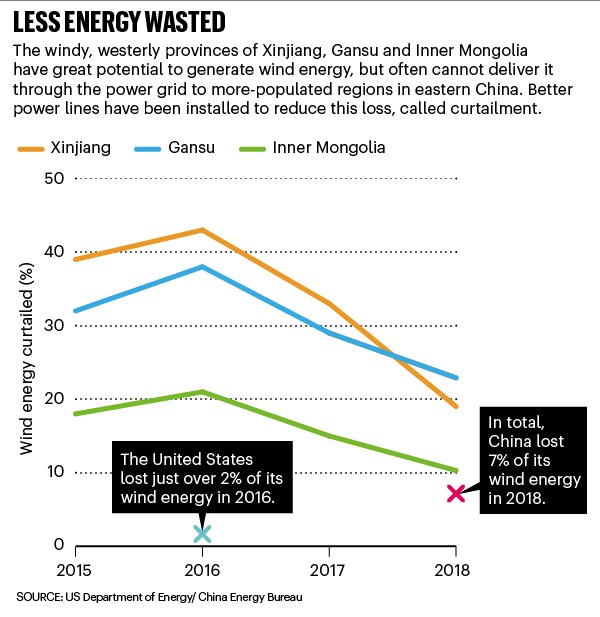
Sources: US Dept of Energy/China National Energy Administration
It’s a dilemma that has led the Chinese government to invest billions of dollars in high-voltage lines, to transmit power generated in sunny, windy regions across the vastness of China. This includes a 22.6-billion-yuan (US$3.2-billion), 1,600-kilometre line from Qinghai in western China, which was completed in May. It runs through Gansu, all the way to Henan province in the centre of the country.
Another way of ensuring that renewable power is available when needed is to increase the capacity for storing it. This can be achieved using technologies such as batteries, pumped-storage hydroelectricity and thermal storage, says Yuki Yu, founder of the clean-energy consultancy Energy Iceberg in Hong Kong.
“Batteries can store excess power, and then release it later. Officials and scientists in China have started to realize the implications of this for stabilizing our power grids,” says Xianfeng Li, who leads the energy-storage division at the Dalian Institute of Chemical Physics (DICP).
In 2017, China released its first national policy document on energy storage, which emphasized the need to develop cheaper, safer batteries capable of holding more energy, to further increase the country’s ability to store the power it produces (see ‘China’s battery boost’). Technologies include lithium-ion batteries — the type used in electric vehicles — and large-scale, stationary battery systems integrated with wind and solar power supplies.
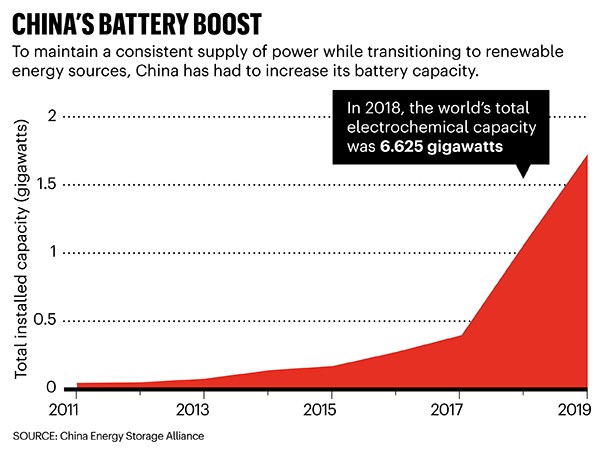
Source: China Energy Storage Alliance
In their plans, policymakers have made it clear that the country’s scientists and engineers need to develop more-effective energy-storage technologies to meet these targets (see ‘Growth in green research’).
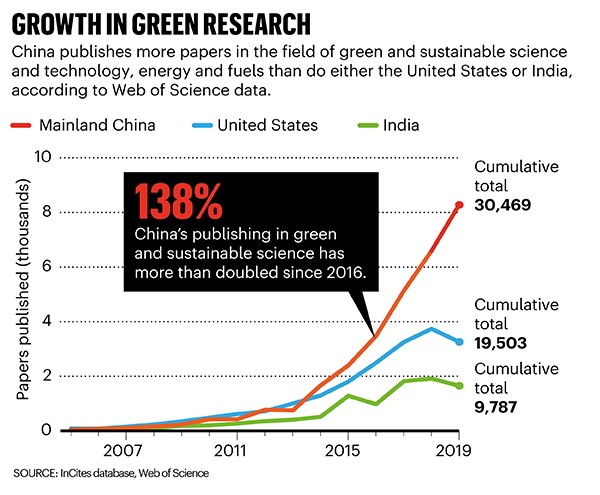
Source: InCites database, Web of Science
Power storage in action
The city of Dalian in Liaoning province, northeast China, has a population of around seven million people, and is a test site for Xianfeng Li’s work. Winter temperatures there can drop to −20 °C, putting the city’s electricity grid under pressure to provide sudden intense bursts when residents turn up their heating, he says.
To help address this need, Rongke Power, a company that was spun off from the DICP, plans to open a 400-megawatt-hour (MWh) energy-storage facility in Dalian this year. It is the first stage in a project to provide an 800-MWh facility by 2023, and will use vanadium flow batteries — huge rechargeable devices that store liquid electrolyte in massive tanks. The final capacity should meet about 0.5% of the total power demand of Liaoning, where Dalian is the second-largest city.
Xianfeng Li says that the project will be able to contribute an uninterruptible power supply to the city, while storing and regulating the supply of energy to the grid for the entire province, which receives 16.2% of its power from renewable energy sources. Provinces vary widely in how much of their energy comes from renewables: for instance, it is 2.7% for the southern Chinese province of Jiangsu, but 30.1% for sunny, sparsely populated Inner Mongolia. Among Liaoning’s neighbours, Jilin receives 8% of its power from non-fossil fuels, and Hebei 9.1%.
How China is redrawing the map of world science
Vanadium flow batteries of the kind Xianfeng Li is testing in Dalian have some advantages over standard lithium-ion batteries for large-scale applications such as grid power: because the vanadium electrolyte is stored in a tank, it can be scaled up much more cheaply than can discrete lithium-ion batteries. Vanadium batteries are also less likely to catch fire, and have around ten times the lifespan of lithium-ion batteries.
Xianfeng Li says that in recent years, he’s seen funding for his work on vanadium flow batteries increase sharply, along with interest from companies in partnering with his team. He says that the DICP is currently working with around 30 companies that have been spun off from the institute.
“Businesses are now interested in developing this technology, because they know the government is focused on it and so feel confident to invest,” he says.
Yu says local governments are now keen to support companies to build battery-storage facilities. “At a time when policymakers are looking for new ways to stimulate growth in their regions, the battery-manufacturing industry looks very promising, so governments are motivated to encourage this type of investment.”
Driving change
The five-year plan for 2016–20 also emphasized the need for researchers to continue developing battery technology so that electric cars can be driven farther on one charge. The bestselling electric vehicle in China, the Tesla Model 3, has a range of around 400 kilometres (most modern electric vehicles have ranges of 160–600 km).
“Developing electric vehicles is another important strategy to reduce pollution, especially when that electricity comes from clean energy. Therefore, we need to develop battery technology for electric vehicles,” says Hong Li, who says he noticed an increase in research funding for energy storage, electric vehicles and other technologies in China in 2012. However, he points out, the country is still catching up on the basic science of energy storage compared with leading labs in the United States and Europe, which excel in understanding fundamental chemistry and materials science. Despite this, he says, China is more active in applying this knowledge to create innovation in advanced battery systems. And the scale of the country’s research environment, from universities to industry teams, has helped scientists in China to reach a comprehensive understanding of how to develop materials and devices for the real world.
Future planning
China has some of the cheapest electricity prices in the developed world (see ‘Electricity prices drop’). The costs are set by local governments and approved by the energy bureau in the National Development and Reform Commission, which oversees macroeconomic policy. Prices are kept low to stimulate economic growth.
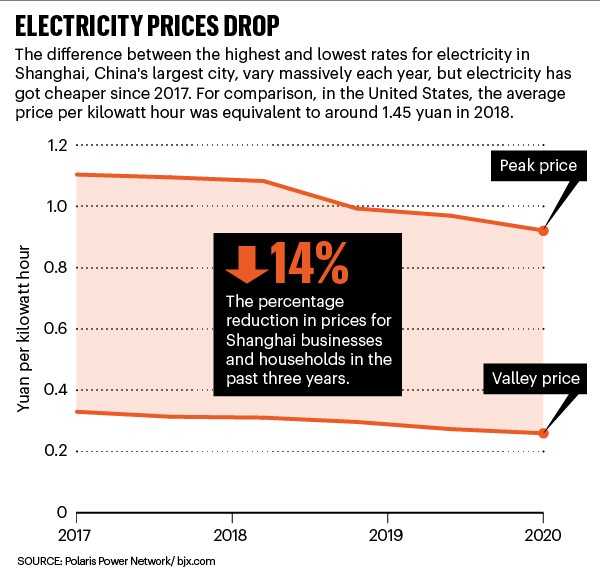
Sources: Polaris Power Network/shoudian.bjx.com.cn (go.nature.com/3tqcemg)
But despite this drive, the country has begun to phase out some subsidies for clean fuels: for example, it will stop those for onshore wind after this year. China’s leaders hope that renewable energy sources will become economically competitive with fossil fuels in the near future. The answer lies in developing stronger energy-storage infrastructure.
Hong Li is an adviser on China’s national planning committee for energy-storage development. Together with engineers and policymakers, the committee is working on a five-year research and development plan that will begin next year. Among other elements, it will encourage scientists to develop energy-storage technologies for the power grid that are intrinsically safer, cheaper and have a longer lifespan.
How the coronavirus pandemic slashed carbon emissions — in five graphs
Solar-power researcher Xianglei Liu, at the School of Energy and Power Engineering at Nanjing University of Aeronautics and Astronautics, says that funding is available for scientists in his field to improve China’s clean energy production. “The government’s ambitious goal to use more clean energy means there is lots of funding,” says Liu.
For example, last year Liu won a 1.3-million-yuan grant from the National Natural Science Foundation of China, the country’s major grant-funding agency, to improve the heat-storage capacity of materials used in solar thermal power plants, which generate power from the heat of the Sun, rather than from its light as photovoltaic panels do. The 5-year project involves around 40 scientists from 6 academic institutes across China. Liu has also recently begun working with the company Nanjing Jinhe Energy Materials to develop a material that has large energy-storage density and high thermal conductivity.
Yi Jin, director of research and development at Nanjing Jinhe Energy Materials, says that because the government is planning to reduce subsidies to renewable-energy companies, the firms that run green power plants are keen to buy or invest in technology that will increase their output and decrease the costs of production.
“Our technology improves the stability of renewable energy and so reduces the costs for power stations, by making them more efficient,” says Jin.
Overall, Hong Li is optimistic that government investment and scientific progress will win out. “As long as we develop the right policies and technologies to support them,” he says, “we can gradually reduce our reliance on coal.”

 The engineer making energy storage more efficient
The engineer making energy storage more efficient
 How China is redrawing the map of world science
How China is redrawing the map of world science
 Can the world kick its fossil-fuel addiction fast enough?
Can the world kick its fossil-fuel addiction fast enough?
 How the coronavirus pandemic slashed carbon emissions — in five graphs
How the coronavirus pandemic slashed carbon emissions — in five graphs
 Rising stars in Earth and environmental sciences 2020
Rising stars in Earth and environmental sciences 2020
 The complex web behind the siting of power plants
The complex web behind the siting of power plants




